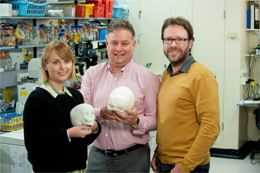28 April 2015
 Adelaide researchers have discovered how the jaw is formed in revolutionary research which provides clues to new treatments for craniofacial defects and common sporting injuries.
Adelaide researchers have discovered how the jaw is formed in revolutionary research which provides clues to new treatments for craniofacial defects and common sporting injuries.
Led by the Centre for Cancer Biology (CCB) – an alliance between the University of South Australia and SA Pathology – the research uncovers a new concept that blood vessels control several aspects of craniofacial development and cartilage growth.
Researchers in the CCB’s Neurovascular Research Laboratory, Dr Sophie Wiszniak and lab head Dr Quenten Schwarz, say the concept of blood vessels controlling craniofacial development is “paradigm changing”.
“We’ve discovered that blood vessels secrete factors that control cartilage growth and that this is essential for craniofacial development,” Dr Schwarz says.
“The discovery has potential applications for therapies for any cartilage defect, whether that’s craniofacial defects through to sporting injuries.”
Published today in the prestigious journal Proceedings of the National Academy of Science PNAS, the research is a collaboration between the CCB, Australian Craniofacial Unit and University College London.
The research paper, titled: ‘Neural crest cell-derived VEGF (Vascular Endothelial Growth Factor) promotes embryonic jaw extension’, details how the researchers used unique mouse models to show blood vessel defects resulted in jaw anomalies.
“What we found was that if there are no blood vessels on one side of the jaw, the jaw on that particular side of the face did not form properly,” Dr Schwarz says.
“There was a direct relationship between blood vessels, supporting and supplying signals to make the jaw cartilage grow.”
Dr Schwarz says jaw formation is different to long bone formation, in which cartilage forms and turns into bone.
“What happens with the jaw during embryogenesis – the very early stages of prenatal development – is that the cartilage is laid down like a scaffold and later surrounded by bone,” he says.
“That cartilage is known as Meckel’s cartilage and while it was first described by Johan Meckel more than 180 years ago, since then we haven’t really known much about it.
“Our work now demonstrates that an intricate association between a specialised population of stem cells called neural crest cells and blood vessels plays an important role in promoting proliferation of the cells found in healthy cartilage to control correct jaw formation.
“This provides novel insight into the origins of craniofacial defects by showing that compromised cardiovascular function, or formation, during critical stages of embryogenesis gives rise to common birth defects.”
The researchers also used cell culture models to demonstrate that blood vessel derived factors, known as angiocrine factors, promote extension of Meckel’s cartilage.
Identification of these angiocrine factors now holds the key to new treatments for disorders in which the cartilage is affected – ranging from craniofacial defects through to common sporting injuries.
The researchers are now working on identifying these factors and potential application for new therapies, which Australian Craniofacial Unit Director of Research Professor Peter Anderson says could improve the lives of children affected by craniofacial anomalies.
In its 40th year, the Australian Craniofacial Unit performs tremendous work through skilled surgical intervention to relieve often terrible outcomes from birth anomalies as well as traumatic head injuries.
“Craniofacial anomalies affect around one in every 500 babies,” he says.
“Our discovery that blood vessels control craniofacial development and cartilage growth could one day result in therapies where we can use injections to promote blood vessel growth in certain anomalies as an alternative or complement to surgical intervention. It has opened the door to exciting further research.”
CCB co-Directors Professors Angel Lopez and Sharad Kumar say the CCB’s specialist knowledge in basic cell biology has important application across a broad range of medical settings.
“The CCB’s Neurovascular Research Laboratory looks at how different cells in the embryo form and essentially how we get to a healthy newborn child,” Prof Lopez says.
“While their work on neural crest cells is pertinent to this body of work, it also informs work the lab is doing on neuroblastoma – the most common extra cranial solid cancer in childhood.
“Neuroblastoma forms in neural crest cells because they don’t differentiate properly. The more we understand about these cells and about development in the first place, the more we understand about diseases, and the more we’ll be able to understand ideas on how to treat them.”
The research paper, titled: ‘Neural crest cell-derived VEGF promotes embryonic jaw extension’, can be downloaded in full from PNAS. For more information and details visit the CCB website.
Contact for interview: Quenten Schwarz office (08) 8222 3714 email quenten.schwarz@health.sa.gov.au
Media contact: Kelly Stone office (08) 8302 0963 mobile 0417 861 832 email Kelly.stone@unisa.edu.au




